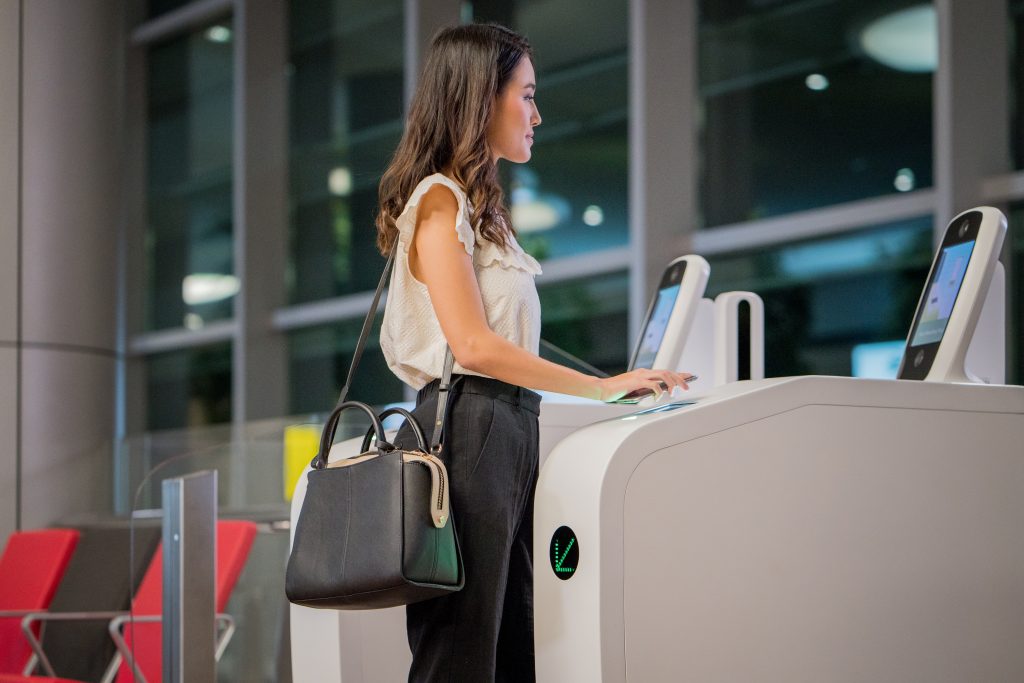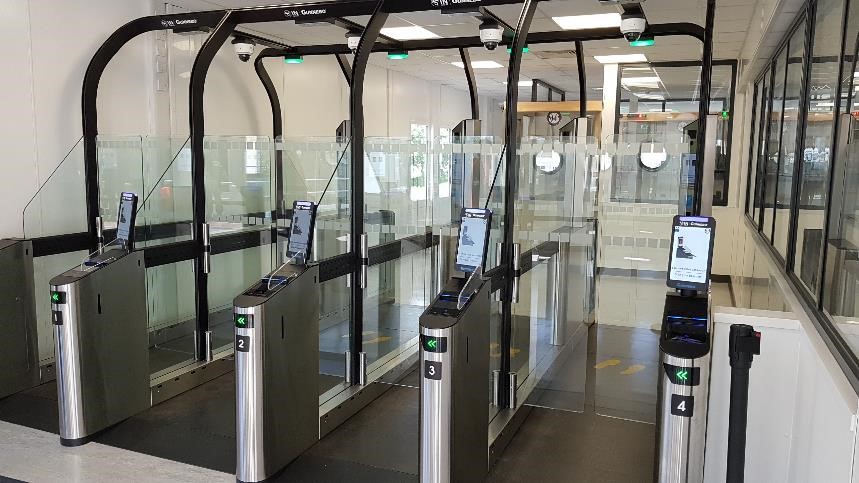The European Entry-Exit System (EES) is scheduled to come into force in February 2022. Operated by eu-LISA, the European large-scale IT systems agency, EES will require collection of biometric data from third-country nationals and will record their every crossing of European Union (EU) Schengen borders. Designed to modernize borders, combat crime and detect overstaying travelers, it will replace manual passport stamping and could enable seamless future passenger flows at immigration. But for now, airports are concerned about its potential to create operational problems, especially if an implementation timeline conceived pre-Covid is pushed through without adequate funding.
“We’ve shared our experiences between airports and, I must admit, some of us are quite concerned,” says the head of ACI Europe’s border control taskforce, Marie-Eve Albertelli. “Member states are responsible for border control, not airports, and some have selected less efficient processes.” Many countries will adopt ACI’s favored smart border configuration, but elsewhere, less effective solutions could present airports with serious bottlenecks when post-Covid traffic returns. “Border control areas must be adapted, but airports are constrained in terms of space,” Albertelli continues. “We are also concerned about finance, because none of us has money to invest.”
Federico Bonaudi, ACI Europe’s head of facilitation, adds, “The Schengen Border Code is very clear. It says member states shall provide sufficient staff and resources – and the regulation provides funding for that.” Nevertheless, member states may use this money to upgrade internal government systems, Bonaudi warns. “While some, like Germany, comply strictly with European requirements, others ask airports to pay,” he explains. “But now airports have no traffic and no aeronautical revenues. The Connecting Europe Facility instrument already provides rail with 10 times more funding than air transport and it’s hard for airports to secure state aid.” Even where member states do fund EES equipment, airports must finance works needed to adapt border control areas, Bonaudi cautions.
Process times may increase
EES is estimated to cost €480m (US$570m) and it will rely on a shared biometric matching system (sBMS) to handle biometrics from 400 million third-country nationals by 2022. “It’s the underlying biometric engine for EES,” explains Emmanuel Wang, border control and passenger flow facilitation vice president at Idemia, which will deliver the eu-LISA system together with Accenture and Sopra Steria. “On first entry, travelers are identified with two biometric modalities – fingerprints and face – then checked against previous travelers to ensure they haven’t used another identity. On subsequent crossings, they are simply verified with one of those biometrics.”
The sBMS will also serve existing EU systems such as the Visa Information System (VIS), European Asylum Dactyloscopy Database (Eurodac) and the future European Criminal Records Information System for Third-Country Nationals (ECRIS-TCN). “That will ease pressure at borders, where today guards must access several, isolated systems,” says Wang. “In the future, they will have a single window on European systems. The sBMS will be the backbone of biometric matching for all European questions of liberty, security and justice.”
Fundamentally, capturing new biometric and alphanumeric data will increase process times for non-Schengen travelers. “Mathematically, of course, it takes more time,” Wang concedes. “Airports already have bottlenecks and limited scope to change physical layouts. The challenge is to not inflate the problem.”
Eu-LISA pilots at French, German and Romanian borders have tested candidate technologies and biometric modalities, confirming the system can capture just four fingerprints, rather than 10. But according to Bonaudi, assessment of impacts on airport throughput has been limited and results not readily shared by internal ministries. “Projected process-time increases vary from 5 to 20 seconds per passenger,” he says. “But those are just estimations, because the system doesn’t yet exist.”
Responsibility lies with member states, but airports may bear the brunt if deployments are botched. Proactive dialog is therefore crucial to shaping workable solutions. “Airports already collaborate closely with border authorities,” says Wang. “They are pushing for efficient, user-friendly solutions and contactless technologies.” One example is MorphoWave, an Idemia solution enabling travelers to provide four-fingerprint biometric data by waving their hand past a sensor without touching it. “That’s efficient both in terms of process time and hygiene, which matters to airports right now,” adds Wang.

Smart border investments
ACI Europe sets out three alternative system layouts for EES implementation: classic border, pre-check and smart border configurations. Choices will depend on individual airport contexts, but ACI Europe advocates the smart border as the best configuration for major hubs with many non-Schengen flights. SITA, like Idemia, has developed front-end smart border solutions to support EES. Central to these are self-service biometric kiosks, where passengers perform more time-consuming process components away from the border itself.
“On first entry, passengers typically enroll as individuals, using the kiosk,” explains SITA border management vice president Jeremy Springall. The kiosk validates documents, captures biometrics and obtains necessary declarations. Passengers then proceed to a manned point of entry to be risk assessed and directed to an e-gate. “We have a two-step process within the gate,” Springall continues. “First, it scans your passport, taking about four seconds. As you enter the gate, a camera on the other side is scanning your face. Because it does that while you’re walking, the person behind is already scanning their passport, which typically saves five seconds in process time.”
Worldwide, SITA has implemented more than 5,000 self-service kiosks covering a variety of airport processes. The company is confident its newly released TS6 ABC Kiosk provides a robust, EES-compliant solution for faster, automated processing. “We’re keen to ensure that what we implement now has longevity and can adapt to future changes,” says Springall. “We’ve focused on a modular, sustainable solution. Obviously, you need as much automation as possible. But you also need high-resolution camera capability to capture biometrics at the detailed level the EU requires. We also minimize the number of working parts, and therefore maintenance issues
for border agencies.” But what if airports are asked to pay for equipment they can ill afford?
“Our advice to members is to remind member states of their obligations under the Schengen Border Code,” says Bonaudi. “It’s difficult, but we provide them with tools to negotiate with national authorities.” He also believes regulators failed to properly consider the most sensible method of implementing EES. “We advocated that passengers should pre-register,” he explains. “Prior to arrival, biometric data could be captured via an app, outside of airport premises. But current regulation does not foresee that possibility.”

Challenges ahead
Where airports must finance equipment, it will entail lengthy tender procedures. Before EES commences operations, each member state must submit a declaration of readiness for every land, sea and air border: this should be done by June 2021, Bonaudi estimates, to make the February 2022 start date achievable. Given the uncertainties around implementation and the unforeseen difficulties of Covid, he believes this EU deadline should now be reconsidered.
“Operations are scheduled to start in February 2022,” says Wang. “The sBMS will be ready, but the challenge is to have all stakeholders, end to end, working together. Because it’s not just at the European level; it must also work at member-state level, down to every guard at every border crossing.”
Procuring equipment, adapting processes and training staff are just the tip of the iceberg; below sea level lurks the challenge, for each member state, of building or adapting national entry-exit systems to manage the new biometric and alphanumeric data. “Delivering EES within the current timeline will require a great deal of collaboration between the industry and governments,” comments Springall.
Premature implementation could have dire operational consequences for airports. “Implementation is the responsibility of member states,” says Albertelli. “The regulation goes live when every member state publishes its readiness declaration. But there’s so much politics involved.”
Hence, she believes, no major country will admit it isn’t ready. “As soon as border systems are connected to the central European system, you can process passengers manually and say you are ready,” she continues. “But does this mean the airport is ready? If we have no traffic, we have no income, so how can we finance works or new equipment? These deadlines were set long before the crisis.”
In future, passengers may sail through every airport touchpoint with one biometric identifier, frictionlessly and physically distanced. Idemia has created such an end-to-end experience at Singapore Changi, and SITA recently provided more than 600 biometric checkpoints throughout Beijing Capital International. In Europe, data-sharing safeguards limit the scope for biometrics to fan out from borders to bag drop or boarding, at least for now.
Meanwhile, the world watches for the success of EES, which, as airports start to coax back travelers, must not be imposed to the detriment of passenger experience. “EES brings great opportunities,” says Wang, “but our first priority is helping airports in their daily work. That means ensuring people travel again, so that we all come through this crisis in relatively good shape.”

